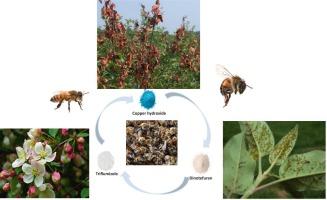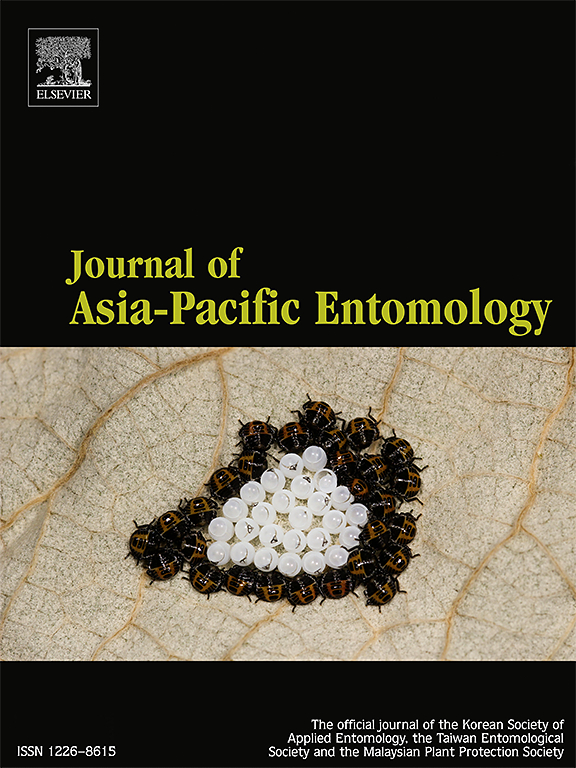Possible interactive risk of copper hydroxide, inorganic bactericide of fire blight with dinotefuran and triflumizole on honey bee
IF 1.3
3区 农林科学
Q3 ENTOMOLOGY
引用次数: 0
Abstract
In spring 2021, abnormal honey bee mortality was observed near apple orchards in Cheongsong, South Korea, following copper-based fire blight control. This study evaluated the acute toxicity of copper hydroxide and basic copper sulfate to honey bees, assessed residue levels in field-collected bees, and investigated potential synergistic effects with co-occurring pesticides. Five-step serial dilutions of the recommended field concentration (RFC) were used for acute oral and contact toxicity assays. ICP-OES was used to quantify copper residues in lab-exposed and field-collected bees, while multi-residue pesticide analysis was performed with LC-MS/MS and GC–MS/MS. Copper hydroxide showed the highest oral toxicity, with both LD50 and HQ values indicating moderate toxicity. Field-collected bees exhibited higher copper bioaccumulation than control, comparable to lab-exposed bees with a 10−2 RFC dilution, which remained well under the LC50. This implies that copper alone is not the cause of the witnessed phenomenon. Among detected pesticides, dinotefuran exhibited high HQ values, exceeding elevated risk threshold. Triflumizole and buprofezin showed minimal risk; however, triflumizole was considered likely to interact with dinotefuran, with their short half-lives potentially contributing to increased toxicity in bees. The combination of copper, dinotefuran, and triflumizole suggests potential interactive toxicity contributing to the observed mortality. These findings underscore the need to account for pesticide mixtures in practical management strategies, as even low-risk compounds can contribute to elevated toxicity when applied together. To prevent unintended harm to honey bees, a more integrated and pollinator-conscious approach to pesticide use is essential.

氢氧化铜、无机杀菌剂与呋喃、三氟唑对蜜蜂可能的交互作用风险
2021年春季,在韩国青松市的苹果园附近,在铜基火疫病防治之后,观察到蜜蜂死亡率异常。本研究评估了氢氧化铜和碱式硫酸铜对蜜蜂的急性毒性,评估了现场采集蜜蜂的残留水平,并研究了它们与共效农药的潜在协同效应。五步连续稀释推荐场浓度(RFC)用于急性口服和接触毒性试验。采用ICP-OES定量实验室接触和野外采集的蜜蜂体内铜残留,采用LC-MS/MS和GC-MS /MS进行多残留农药分析。氢氧化铜的口服毒性最高,LD50和HQ值均为中等毒性。野外采集的蜜蜂表现出比对照更高的铜生物积累,与实验室暴露的蜜蜂相比,RFC稀释为10−2,但仍保持在LC50以下。这意味着铜本身并不是所见现象的原因。在检测到的农药中,敌敌畏的HQ值较高,超过了风险升高阈值。三氟唑和丁丙非津风险最小;然而,三氟唑被认为可能与呋虫胺相互作用,它们的半衰期较短,可能会增加蜜蜂的毒性。铜、呋虫胺和三氟唑的联合作用提示潜在的相互作用毒性导致观察到的死亡率。这些发现强调了在实际管理策略中考虑农药混合物的必要性,因为即使是低风险化合物在一起使用时也可能导致毒性升高。为了防止对蜜蜂造成意外伤害,对农药的使用采取一种更综合、更注重传粉媒介的方法至关重要。
本文章由计算机程序翻译,如有差异,请以英文原文为准。
求助全文
约1分钟内获得全文
求助全文
来源期刊

Journal of Asia-pacific Entomology
Agricultural and Biological Sciences-Insect Science
CiteScore
2.70
自引率
6.70%
发文量
152
审稿时长
69 days
期刊介绍:
The journal publishes original research papers, review articles and short communications in the basic and applied area concerning insects, mites or other arthropods and nematodes of economic importance in agriculture, forestry, industry, human and animal health, and natural resource and environment management, and is the official journal of the Korean Society of Applied Entomology and the Taiwan Entomological Society.
 求助内容:
求助内容: 应助结果提醒方式:
应助结果提醒方式:


